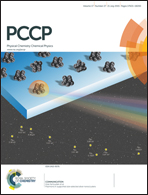Exploring the nature of the excitation energies in [Re6(μ3-Q8)X6]4− clusters: a relativistic approach†
Abstract
This contribution is a relativistic theoretical study to characterize systematically the main electronic transitions in a series of hexarhenium chalcogenide [Re6(μ3-Q8)X6]4− clusters with the aim of understanding: (i) the terminal ligand substitution effect, (ii) the substitution effect of the chalcogenide ion on the [Re6(μ3-Q8)]2+core, and finally (iii) the significance of the spin–orbit coupling (SOC) effect on the optical selection rules. In all the cases, we found characteristic bands at around 300–550 nm, where the band positions are directly determined by the terminal ligand. However, SCN−/NCS− presents a different nature of the orbitals involved in the electronic transitions, in comparison with the other studied terminal ligands, located in the near-infrared (NIR) region. All the bands are red-shifted as a consequence of the ligand contribution in the composition of the orbitals involved in the electronic excitations.
![Graphical abstract: Exploring the nature of the excitation energies in [Re6(μ3-Q8)X6]4− clusters: a relativistic approach](/en/Image/Get?imageInfo.ImageType=GA&imageInfo.ImageIdentifier.ManuscriptID=C5CP02003D&imageInfo.ImageIdentifier.Year=2015)

 Please wait while we load your content...
Please wait while we load your content...